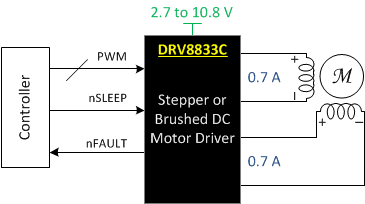ZHCSCV7 August 2014 DRV8833C
PRODUCTION DATA.
1 特性
- 带电流控制的双 H 桥电机驱动器
- 1 个或 2 个直流电机或者 1 个步进电机
- 低导通电阻:高侧 + 低侧 (HS + LS) = 1735mΩ(25°C 时的典型值)
- 输出电流能力(VM = 5V,25°C 时)
- 散热薄型小外形尺寸 PWP (HTSSOP) 封装
- 每个 H 桥的均方根 (RMS) 电流为 0.7A,峰值 1A
- 并行模式下 RMS 为 1.4A
- 四方扁平无引线 RTE (QFN) 封装
- 每个 H 桥的均方根 (RMS) 电流为 0.6A,峰值 1A
- 并行模式下 RMS 为 1.2A
- 散热薄型小外形尺寸 PWP (HTSSOP) 封装
- 宽电源电压范围
- 2.7V 至 10.8V
- 集成电流调节
- 简易脉宽调制 (PWM) 接口
- 1.6µA 低电流睡眠模式(电压 5V 时)
- 小型封装尺寸
- 16HTSSOP (PowerPAD™) 5.00 × 6.40mm
- 16 QFN (PowerPAD) 3.00 × 3.00mm
- 保护特性
- VM 欠压闭锁 (UVLO)
- 过流保护 (OCP)
- 热关断 (TSD)
- 故障指示引脚 (nFAULT)
2 应用
- 销售点打印机
- 视频安保摄像机
- 办公自动化设备
- 游戏机
- 机器人
- 电池供电式玩具
3 说明
DRV8833C 为玩具、打印机及其他机电一体化应用提供了一款双桥电机驱动器解决方案。
该器件具有两个 H 桥驱动器,能够驱动两个直流电刷电机、一个双极性步进电机、螺线管或其它电感性负载。
每个 H 桥输出都包括一对 N 通道和 P 通道金属氧化物半导体场效应晶体管 (MOSFET) 以及用于调节绕组电流的电路。 借助正确的印刷电路板 (PCB) 设计,DRV8833C 的每个 H 桥能够持续驱动高达 700mA RMS(或 DC)(在 25°C 采用 5V VM 电源时)。该器件可支持每个 H 桥高达 1A 的峰值电流。 在较低的 VM 电压条件下,电流能力略有下降。
输出引脚发生故障时,还可提供用于过流保护、短路保护、UVLO 和过热保护的内部关断功能。 另外,还提供了一种低功耗睡眠模式。
器件信息(1)
| 部件号 | 封装 | 封装尺寸(标称值) |
|---|---|---|
| DRV8833C | HTSSOP (16) | 5.00mm x 6.40mm |
| 四方扁平无引线 (QFN) (16) | 3.00mm x 3.00mm |
- 要了解所有可用封装,请见数据表末尾的可订购产品附录。
